11+ Sample Skills Gap Analysis
-
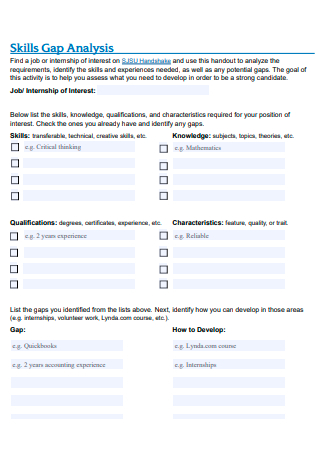
Skills Gap Analysis Template
download now -
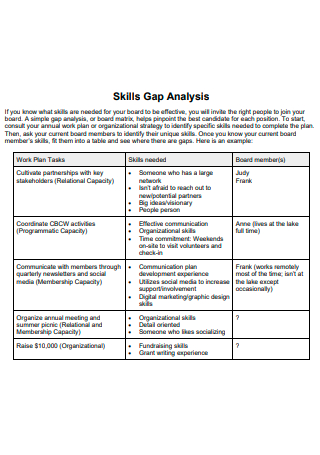
Basic Skills Gap Analysis
download now -
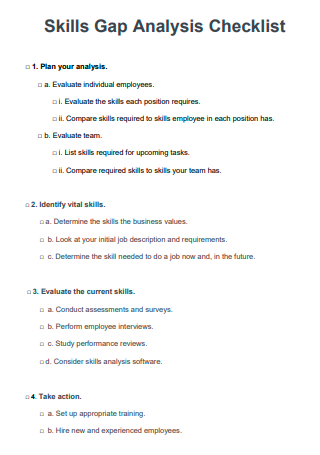
Skills Gap Analysis Checklist
download now -

Skills Gap Analysis in PDF
download now -

Space Industry Skills Gap Analysis
download now -
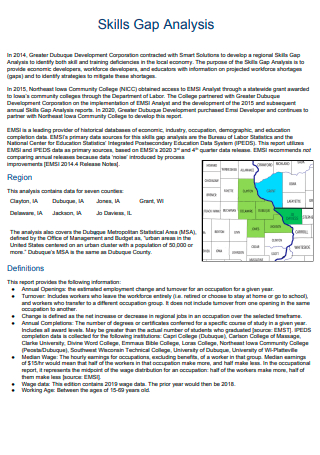
Printable Skills Gap Analysis
download now -

Skills Gap Analysis Example
download now -
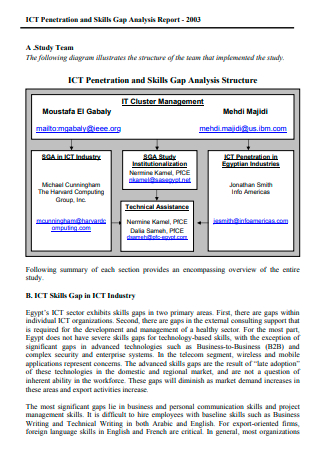
Skills Gap Analysis Report
download now -
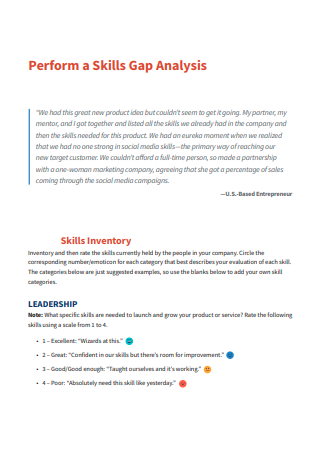
Simple Skills Gap Analysis.
download now -
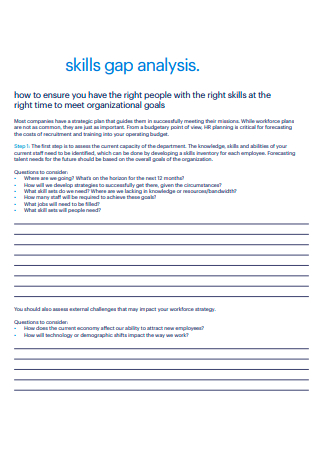
Skills Gap Analysis Format
download now -
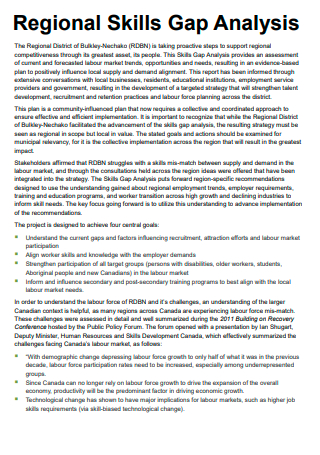
Regional Skills Gap Analysis
download now -
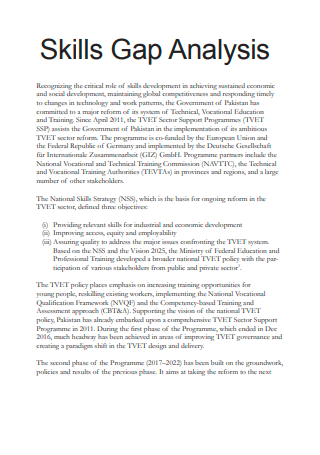
Standard Skills Gap Analysis
download now
FREE Skills Gap Analysis s to Download
11+ Sample Skills Gap Analysis
What Is a Skill Gap Analysis?
Benefits of Having Soft Skills at Work
Tips to Identify Company Skill Gaps
How to Conduct a Skills Gap Analysis
FAQs
What is a gap analysis example?
What is an HR gap analysis?
Which skill is highly required by employees?
What Is a Skill Gap Analysis?
Organizations use skill gap analysis to measure the difference between the skills required and the skills currently possessed by their employees. HR assesses the employees’ skill gaps to determine their performance and evaluate their lack of field knowledge. The authority then works towards bridging these gaps by providing required skill courses, L&D investment decisions, and succession planning, among other things. According to McKinsey & Company, most companies worldwide (87%) know they have a significant skills gap or will have one within a few years.
Benefits of Having Soft Skills at Work
Numerous organizations prioritize performance management and product knowledge training because they directly impact sales. However, they fail to acknowledge the significance of soft skills. Although communication, conflict resolution, and problem-solving are fundamental to every aspect of business operations, these skills are often overlooked. Employees in every department and position must hone their interpersonal skills to improve customer service statistics and foster a strong team dynamic. However, this is only the tip regarding workforce development. Here are a few advantages demonstrating the significance of developing soft skills in the workplace.
Tips to Identify Company Skill Gaps
We are witnessing a global skills revolution, in which reskilling employees has become a new business priority to help them quickly adapt to the economy’s rapid transformation. According to McKinsey & Company, most companies worldwide (87%) know they have a significant skills gap or will have one within a few years. Utilize this simplified 5-step process to get to the bottom of your most pressing skill gaps:
1. Determine your company’s goals
While it may seem desirable to have employees with a wide range of skills, the reality is that your business probably requires one skill more than another. You can better determine your employees’ current and future training needs by identifying your company’s goals. This is how you decide if technology training, customer service skills, or something else is more important. Don’t ignore this initial step. You must invest the same time and effort in learning about your organization’s objectives while developing its training programs.
2. Dissect skills based on specific occupations
Again, it may be desirable for all your employees to possess customer service abilities and be well-rounded. Still, your IT staff will likely require much less training than your sales staff or call center representatives. To ensure that you are not training your employees in the wrong areas, you must first identify essential skills for each job type in your organization and then assess the skills your employees already possess. Create a list of these skills and ensure that managers know what their team members are expected to know and their anticipated level of expertise.
3. Determine which skills employees already possess
Now that you clearly understand your business’s priorities and the skills required for each position, you will need to assess whether the individuals in those positions are adequately equipped to perform their duties. Do not assume that your employees know what to do. Even long-term employees may have skill gaps if specific skills are no longer required frequently or if their job has become specialized. Assessing essential skills needed for a particular job will provide the information necessary to proceed to Training Needs Analysis (TNA). With the TNA, you compare an employee’s skills to their current level of knowledge and determine how much training is required.
4. Start closing gaps
Now that the gaps have been identified, it is time to close them. At this point, you can begin developing training and hiring action plans. Due to the time and expense associated with the activity, it is best to start by closing the most critical gaps; therefore, you should establish your priorities before developing a training program. Each plan should include why employees should improve these skills, the most effective ways to address the gaps, the necessary support, and a deadline by which the training must be completed. You have numerous options for closing the gaps, including coaching, mentoring, and e-learning programs.
How to Conduct a Skills Gap Analysis
The benefits of executing a skills gap analysis justify the costs associated with doing so. Employees can also benefit significantly from the process of skills gap analysis. A skills gap analysis, for instance, can lead to more targeted opportunities for professional development and career advancement. When such opportunities are provided, employees feel valued. Additionally, it strengthens their sense of belonging and may increase retention. Here are five steps to get started.
Step 1: Preparation and planning
Determine who will participate in the skills gap analysis first. Include key stakeholders, such as organizational leaders, HR personnel, business managers, and those likely to champion change. Without preconceived notions of what the solution ought to be, the project manager must develop a mentality that supports skills gap analysis. This starts with transparency regarding the process and its objectives. Suppose skills gap analysis is new to an organization. In that case, it should be preceded by internal discussions about the skills required to accomplish the organization’s work rather than the requirements for specific positions. This way of thinking can hinder the selection of the most effective means to close gaps. In addition to establishing a project schedule and determining how skills measurement data will be collected and analyzed, other important planning considerations include establishing a project timeline and determining how skills measurement data will be collected and analyzed.
Step 2: Identify skills needed
The second step aims to determine which skills the organization must retain, develop, or acquire soon. Create a list of the likely skills the organization will require within the next five to ten years. Additionally, the project manager can inquire with the executive team about any significant initiatives or projects in the planning stages. Consult with frontline managers and talent acquisition personnel to obtain their perspectives on the required skills. Finally, map the list of skills needed for organizational goals to ensure that the list is exhaustive. At this point, it can be practical to rank the list of skills according to the importance and required skill level.
Step 3: Measure existing skills
Determine the extent to which the required skills already exist within the organization in step three. Start with readily available data, such as performance reviews, 360-degree feedback, or resumes submitted by employees. Combining self-assessments, surveys, interviews, focus groups, KPI analyses for teams and individuals, etc., can be used to collect additional data. Ensure that managers review and confirm the self-ratings of their team.
Step 4: Identify the gaps
Once all data has been collected, compare the results of steps two and three to determine which required skills are inadequately represented in the current skills inventory. Creating a skills spreadsheet for each team and individual is a best practice. List the necessary skills for success and, for each skill, indicate its importance, the required level of performance, and the actual level of execution, all on a five-point scale. A skill rated “high” in stature and “high” in required performance level but “low” in actual performance would indicate a team-wide skill gap. A similar disparity between required performance and actual performance of an essential skill for an individual team member suggests a skill gap for that team member. The outcome of step four is a comprehensive, prioritized list of the skills lacking throughout the organization that is essential to the team and individual success. Before taking action, disseminate these results to all interested parties and solicit their feedback.
Step 5: Close skills gaps
The fifth step may involve multiple projects and continue for a considerable time. Individual professional development plans and courses, conferences, and certifications are examples of L&D initiatives. The L&D team may also participate in the hiring process by, for example, administering skill assessments or participating in panel interviews.
FAQs
What is a gap analysis example?
For instance, if a company desires to launch a marketing campaign to improve its reputation or apply for a loan, it could perform a market gap analysis to determine its impact on the local economy and include that information in its marketing campaign or loan application.
What is an HR gap analysis?
Understanding the gaps between force demand and supply and identifying the gaps with the most significant impact on organizational performance comprise this phase.
Which skill is highly required by employees?
Creativity is one of the most valuable skills you can acquire on the job. Creativity entails devising novel methods to complete tasks, meet challenges, and solve problems. This way of thinking can assist businesses in moving in productive directions. Therefore, creative employees are precious to a business.
A skills gap analysis may be necessary whenever an organization faces the possibility of substantial changes that could affect the work it performs or how it performs it. This may include economic changes, the competitive landscape, consumer demand, and technology. The experience gained from an initial, small-scale analysis can serve as a foundation for similar efforts at the business unit or enterprise levels. Given the magnitude of the changes organizations will face in the coming years, there is no better time than the present to begin.
